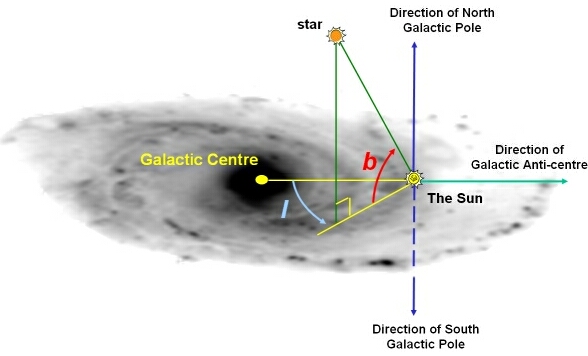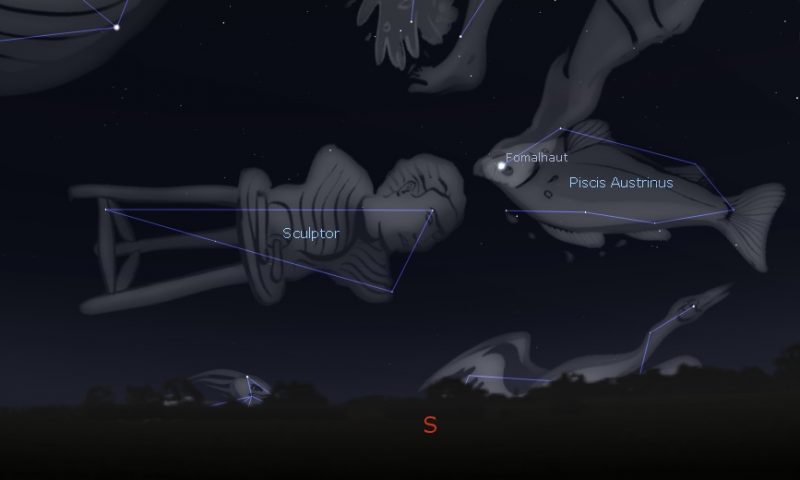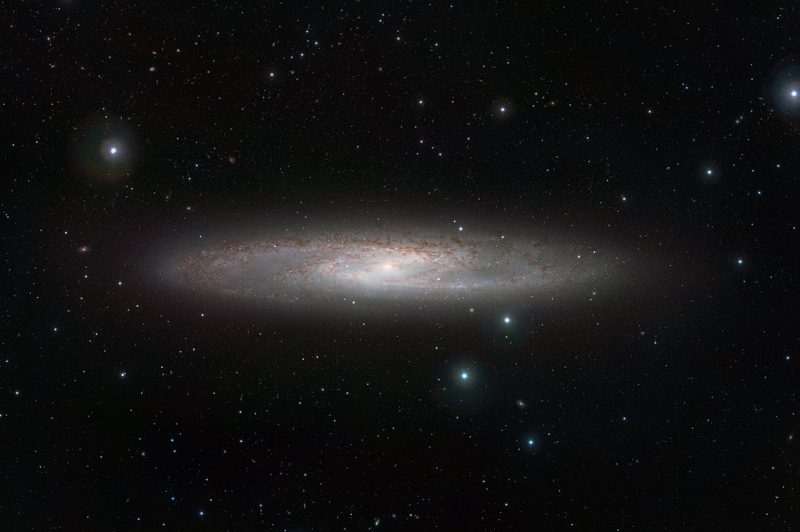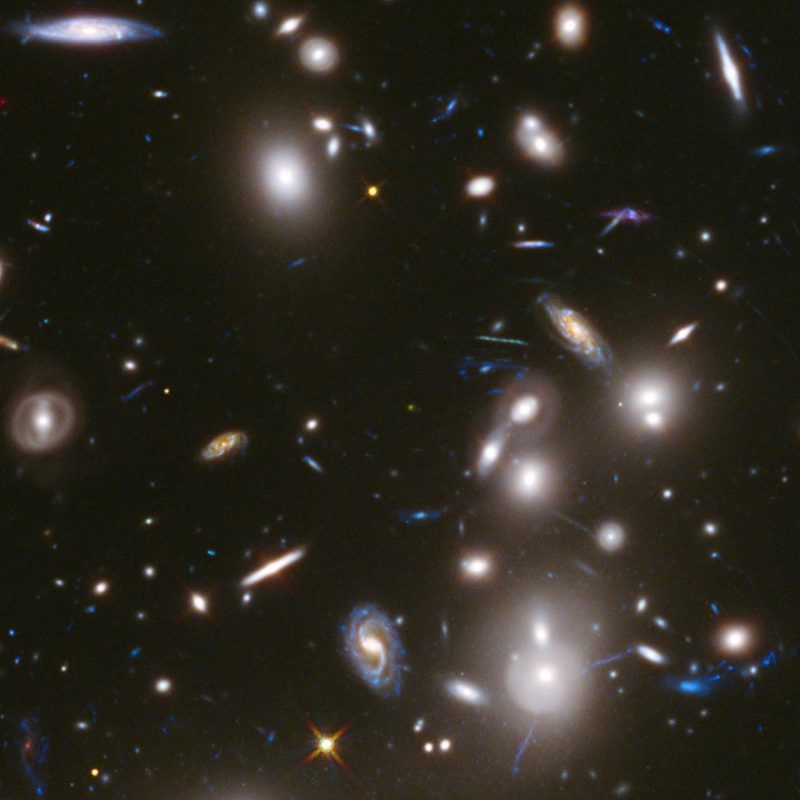
The constellation Sculptor is a quiet patch of dark sky that brushes the southern horizon in November for Northern Hemisphere viewers. Sculptor is one of the 14 constellations named by the French astronomer Nicolas Lacaille (1713-1762), although Lacaille’s original name for this grouping of southern stars was the Sculptor’s Workshop. Either way, these dim stars resemble neither sculptor nor workshop. You might instead pick out a triangle of stars in Sculptor, shown in the chart at the top of this post. Yet this small constellation has a claim to fame. It’s home to the point in the sky astronomers recognize as the South Galactic Pole.
What is the South Galactic Pole?
Imagine us on a galactic scale, within the disk of our home Milky Way galaxy. The galaxy lies all around us in space. It spins, just as Earth spins (and as all objects in space are spinning) around a central axis. The spin axis of the Milky Way runs through its center, making our great spiral galaxy resemble a turning pinwheel. So – in much the same way we on Earth look in our sky toward Polaris, our present-day North Star – so we on Earth can look in the sky toward the North and South Poles of our Milky Way galaxy.
The North Galactic Pole lies in the northern constellation Coma Berenices. And the South Galactic Pole lies in the southern constellation Sculptor. The galactic latitude of that pole would be -90 degrees.
From our earthly vantage point, we can’t see into our galaxy’s center. That’s because nearly all the Milky Way’s visible contents – gas, dust, stars – lie in the flat plane of the galaxy, at 0 degrees galactic longitude. When we look toward the Milky Way’s center, there’s a lot of stuff obscuring our view. between us and the center. But looking toward the poles of the galaxy is different. Then we’re looking up and away from the star-rich plane of the galaxy. We’re looking more clearly into the space beyond our galaxy. And so astronomers say that looking toward Sculptor is like looking out our galaxy’s south window.



How to find Sculptor
People in the Southern Hemisphere can spy Sculptor overhead on November evenings. For Northern Hemisphere observers, you’ll have to have a clear horizon to the south and a dark-sky site. One bright star is in this region of sky, and it doesn’t belong to Sculptor. Fomalhaut, with the nickname of the loneliest star, is part of the constellation Piscis Austrinus. Look east of Piscis Austrinus and below Cetus the Whale with its star Diphda. See that dark empty space? That’s Sculptor.
Sculptor brightest star, Alpha Sculptoris, shines at a mere magnitude 4.3. This means that if you live in a city or nearby suburb, you can’t see any of Sculptor’s stars at all.
Alpha Sculptoris lies about 672 light-years from Earth. One other notable star in Sculptor is Zeta Sculptoris, at magnitude 5.0. A smattering of dimmer stars surround Zeta, giving the cluster the name the Zeta Sculptoris Cluster. Yet Zeta is not actually part of the cluster. The cluster stars are much farther away.

Deep-sky objects in the constellation Sculptor
A little less than 5 degrees from Alpha Sculptoris is the most notable deep-sky object in this constellation: the Sculptor Galaxy. At magnitude 8, you can spot the Sculptor Galaxy – or NGC 253 – through a small telescope. The Sculptor Galaxy is about 13 million light-years distant, making it a member of one of the nearest groups of galaxies to Earth. The galaxy is a spiral that shows a central bar in infrared images.
One advantage of an area of sky that is sparsely populated with stars or other bright space objects is that it makes a great target for Hubble deep field photos. Hubble aimed its telescopes at Sculptor to reveal the massive galaxy cluster Abell 2744. Even more distant galaxies appear through gravitational lensing in this photo. One of the objects in the photo is more than 13 billion light-years away. You may not be able to see these galaxies with your own telescope, but you can enjoy the Hubble image and ponder objects that date from the early days of our universe.
Also above Alpha Sculptoris, but below the Sculptor Galaxy, is the South Galactic Pole. If you want to gae toward this point in the sky with your binoculars or telescope – look out our galaxy’s “south window,” as it were – its geocentric coordinates (right ascension and declination) are RA = 0h 51m 26.00s, Dec = -27d 7m 42.0s.

Bottom line: The constellation Sculptor appears best on November evenings from the Northern Hemisphere, when it lies along the southern horizon.
The post The constellation Sculptor contains the South Galactic Pole first appeared on EarthSky.
from EarthSky https://ift.tt/304UvsM

The constellation Sculptor is a quiet patch of dark sky that brushes the southern horizon in November for Northern Hemisphere viewers. Sculptor is one of the 14 constellations named by the French astronomer Nicolas Lacaille (1713-1762), although Lacaille’s original name for this grouping of southern stars was the Sculptor’s Workshop. Either way, these dim stars resemble neither sculptor nor workshop. You might instead pick out a triangle of stars in Sculptor, shown in the chart at the top of this post. Yet this small constellation has a claim to fame. It’s home to the point in the sky astronomers recognize as the South Galactic Pole.
What is the South Galactic Pole?
Imagine us on a galactic scale, within the disk of our home Milky Way galaxy. The galaxy lies all around us in space. It spins, just as Earth spins (and as all objects in space are spinning) around a central axis. The spin axis of the Milky Way runs through its center, making our great spiral galaxy resemble a turning pinwheel. So – in much the same way we on Earth look in our sky toward Polaris, our present-day North Star – so we on Earth can look in the sky toward the North and South Poles of our Milky Way galaxy.
The North Galactic Pole lies in the northern constellation Coma Berenices. And the South Galactic Pole lies in the southern constellation Sculptor. The galactic latitude of that pole would be -90 degrees.
From our earthly vantage point, we can’t see into our galaxy’s center. That’s because nearly all the Milky Way’s visible contents – gas, dust, stars – lie in the flat plane of the galaxy, at 0 degrees galactic longitude. When we look toward the Milky Way’s center, there’s a lot of stuff obscuring our view. between us and the center. But looking toward the poles of the galaxy is different. Then we’re looking up and away from the star-rich plane of the galaxy. We’re looking more clearly into the space beyond our galaxy. And so astronomers say that looking toward Sculptor is like looking out our galaxy’s south window.



How to find Sculptor
People in the Southern Hemisphere can spy Sculptor overhead on November evenings. For Northern Hemisphere observers, you’ll have to have a clear horizon to the south and a dark-sky site. One bright star is in this region of sky, and it doesn’t belong to Sculptor. Fomalhaut, with the nickname of the loneliest star, is part of the constellation Piscis Austrinus. Look east of Piscis Austrinus and below Cetus the Whale with its star Diphda. See that dark empty space? That’s Sculptor.
Sculptor brightest star, Alpha Sculptoris, shines at a mere magnitude 4.3. This means that if you live in a city or nearby suburb, you can’t see any of Sculptor’s stars at all.
Alpha Sculptoris lies about 672 light-years from Earth. One other notable star in Sculptor is Zeta Sculptoris, at magnitude 5.0. A smattering of dimmer stars surround Zeta, giving the cluster the name the Zeta Sculptoris Cluster. Yet Zeta is not actually part of the cluster. The cluster stars are much farther away.

Deep-sky objects in the constellation Sculptor
A little less than 5 degrees from Alpha Sculptoris is the most notable deep-sky object in this constellation: the Sculptor Galaxy. At magnitude 8, you can spot the Sculptor Galaxy – or NGC 253 – through a small telescope. The Sculptor Galaxy is about 13 million light-years distant, making it a member of one of the nearest groups of galaxies to Earth. The galaxy is a spiral that shows a central bar in infrared images.
One advantage of an area of sky that is sparsely populated with stars or other bright space objects is that it makes a great target for Hubble deep field photos. Hubble aimed its telescopes at Sculptor to reveal the massive galaxy cluster Abell 2744. Even more distant galaxies appear through gravitational lensing in this photo. One of the objects in the photo is more than 13 billion light-years away. You may not be able to see these galaxies with your own telescope, but you can enjoy the Hubble image and ponder objects that date from the early days of our universe.
Also above Alpha Sculptoris, but below the Sculptor Galaxy, is the South Galactic Pole. If you want to gae toward this point in the sky with your binoculars or telescope – look out our galaxy’s “south window,” as it were – its geocentric coordinates (right ascension and declination) are RA = 0h 51m 26.00s, Dec = -27d 7m 42.0s.

Bottom line: The constellation Sculptor appears best on November evenings from the Northern Hemisphere, when it lies along the southern horizon.
The post The constellation Sculptor contains the South Galactic Pole first appeared on EarthSky.
from EarthSky https://ift.tt/304UvsM

Aucun commentaire:
Enregistrer un commentaire